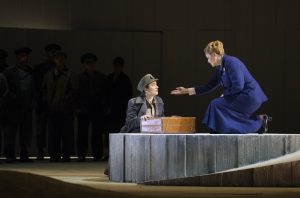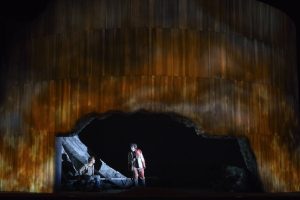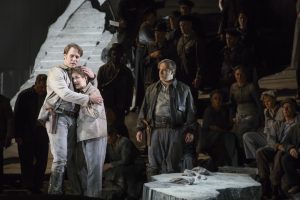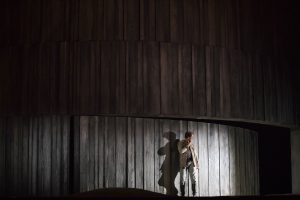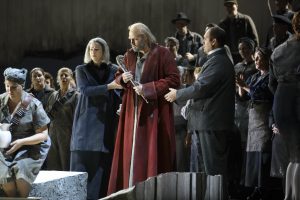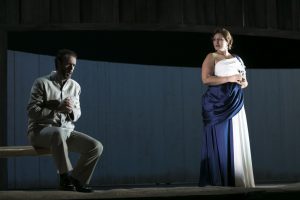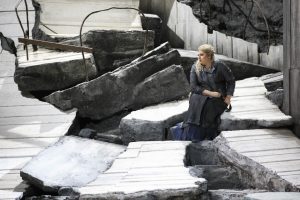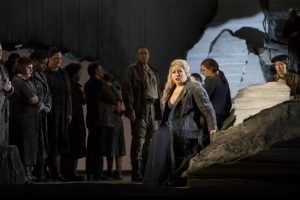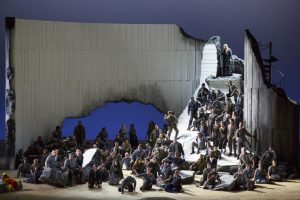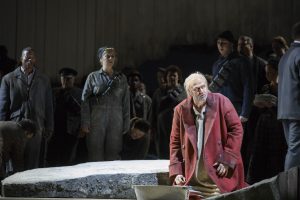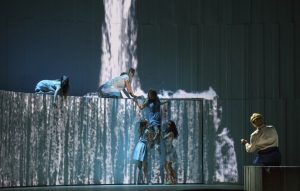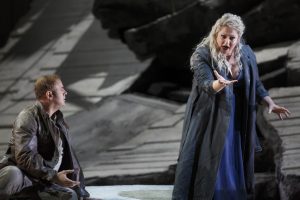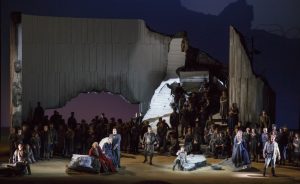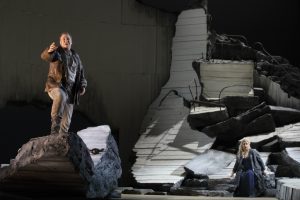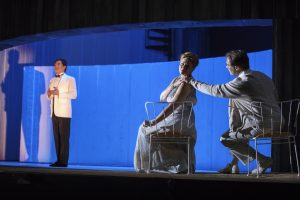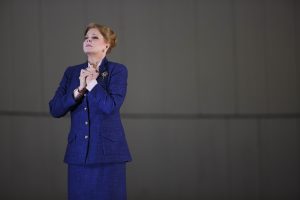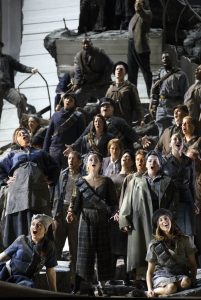WHEN BIGGER ACTUALLY IS BETTER
Everything about Les Troyens is big. Hector Berlioz’s massive opera boasts 5 acts, lasts nearly 5 hours even with numerous small cuts (and two 30-minute intermissions), has 22 named roles, and requires a vastly expanded chorus (about 100 singers) and 2 orchestras (the main one in the pit and another offstage) as well as a short ballet. And then there’s the epic storyline based on Virgil’s Aeneid. It’s no wonder that Les Troyens is so rarely performed. Most opera companies simply don’t have the resources to pull it off.
Lyric Opera’s world-class production, which is the company’s first ever of Les Troyens, succeeds extravagantly. Although a new one, this production follows recent ones at San Francisco, New York, and London—all featuring renowned mezzo-soprano Susan Graham as Didon. The company’s freshly-purchased turntable figures prominently, just as new stage lifts were conspicuous in Wagner’s Das Rheingold, which opened the season. This new equipment was freshly purchased as part of Lyric’s ongoing stage improvement and modernization campaign.
Hector Berlioz wrote just five operas (and of these he only finished three). None of them has ever been very popular or part of the standard repertoire. In the case of Les Troyens, size is obviously the discouraging factor. (Had Berlioz a wealthy patron like Richard Wagner, would his success have been assured?) Instead, Berlioz acquiesced to a much-truncated debut production that hindered the opera’s reception for decades.
Berlioz wrote the libretto himself primarily using material from books II and IV of the Aeneid. The first two acts of Les Troyens portray the destruction of Troy by the Greeks, as prophesied by Cassandra. A small contingent of Trojans led by Aeneas escapes for Italy, but washes up in Carthage first. As Act III begins, Carthage is being threatened by the Numidians, whose king seeks the hand of Dido. Aeneas’s army arrives just in time to save the Carthaginians. The final two acts show the beginning and end of Dido and Aeneas’s love, for although Dido would happily share her kingdom with him, Aeneas reluctantly forsakes her for his fated Italy. In her grief, Dido commits suicide.
Les Troyens is not all doom and gloom, however. Berlioz composes some of the opera’s most beautiful and poignant music for its central romance, from the Act III duet “Les Chants Joyeux” in which Anna urges her sister Dido to fall in love again to the Act IV duet “Nuit d’Ivresse” in which Aeneas and Dido sing of their love. In between is the lyrical tenor aria “Assez, Ma Soeur,” sung ever so sweetly by Mingjie Lee’s Iopas, with harp accompaniment.
Besides the tremendous energy of conductor Sir Andrew Davis and the expanded Lyric Opera Orchestra, a virtuosic cast led by three extraordinary women drives this production with unflagging feeling and dramatic art. It begins with American soprano Christine Goerke as Cassandra, whose rich, powerful voice dominates Act I and expertly expresses all the anguish of her character.
Then it continues with Anna, played by Okka von der Damerau (recently seen as Erda in Das Rheingold) and Dido, played by Susan Graham. There’s something especially elegant about Damerau’s posture and movements, and her sumptuous mezzo-soprano is a perfect match for Graham’s. Although the latter has the most experience in her role, Brandon Jovanovich as Aeneas seems to perform the most effortlessly. His silky tenor easily soars above and beyond the orchestra, chorus, and principals with such grace and finesse that one wishes only to hear more of it. And bass Christian van Horn’s Narbal adds welcome depth and gravitas.
The only aspect of Lyric’s production that is less than captivating is the visual direction, which tends to the plain and drab. While this could be excused in the war-torn Troy of Acts I and II, it is hard to fathom why Carthage is not more decorated nor its people more colorful. For example, German designer Tobias Hoheisel first clothes Dido in an unflattering skirt suit that one would more likely expect to see on the present Queen of England. The costumes look as if they have been scavenged from previous productions in an effort to save money that was spent elsewhere.
Tim Albery, who directed Tannhaüser at Lyric two seasons ago, provides effective direction that absolutely works, however. Using a stage built entirely on top of the new turntable, he is able to make all the action revolve around a single structure and vice versa. And this structure, which is ruined in Acts I and II and whole in Acts III through V, provides a versatile unity that ingeniously ties together the action throughout.
One could easily say much more about this grandiose opera, but who wants to read a grandiose review? This one is long enough. What audiences need to know about this opera is that it is most definitely worth the time and money. Moreover, preparation is essential. Get lots of rest beforehand, wear comfortable clothes, and be sure to bring or buy food during the intermissions.
Les Troyens (The Trojans)
The Second City & Lyric Opera of Chicago
Civic Opera House, 20 N. Wacker Drive
ends on December 3, 2016
for tickets, call 312.827.5600 or visit Lyric Opera
for more shows, visit Theatre in Chicago
![Post image for Chicago Opera Review: LES TROYENS [THE TROJANS] (Lyric Opera of Chicago)](https://stageandcinema.com/wp-content/uploads/2016/10/les-troyens-lyric.jpg)
